the wide-scale transition of many human cultures during the Neolithic period from a lifestyle of hunting and gathering to one of agriculture and settlement,
making an increasingly large population possible. These settled communities permitted humans to observe and experiment with plants to learn how they grew and
developed. This new knowledge led to the domestication of plants.
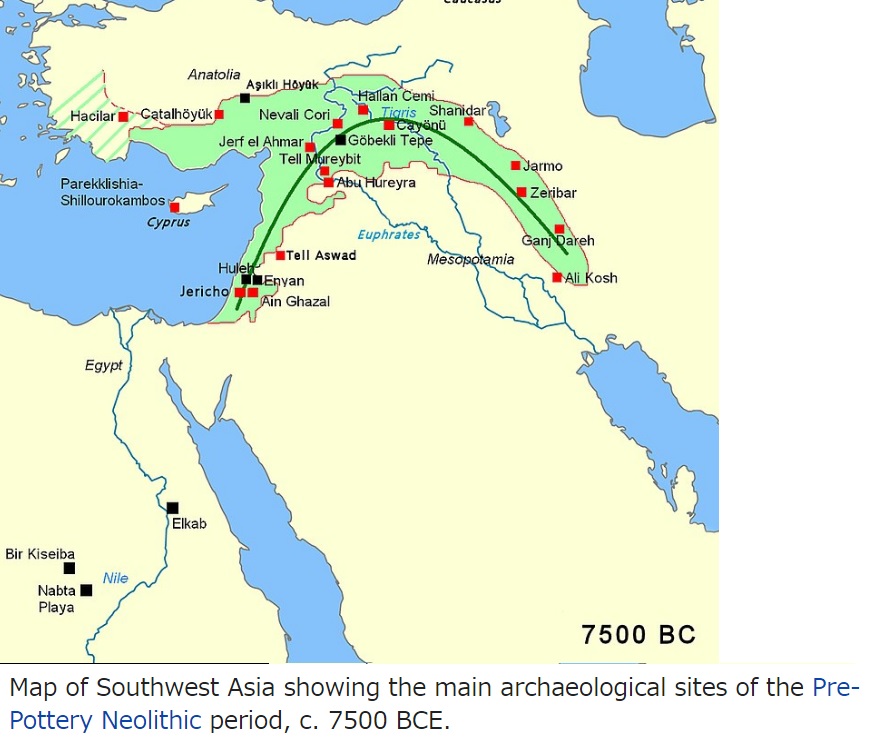

Mesopotamia
(from c. 10000 BC) [Today part of Iraq, Kuwait, the eastern parts of Syria, Southeastern Turkey] the site of the earliest developments of the Neolithic
Revolution from around 10,000 BC. It has been identified as having "inspired some of the most important developments in human history, including the
invention of the wheel, the planting of the first cereal crops, and the development of cursive script, mathematics, astronomy, and agriculture."
The Sumerians and Akkadians (including Assyrians and Babylonians) dominated Mesopotamia from the beginning of written history (c. 3100 BC) to the fall of
Babylon in 539 BC, when it was conquered by the Achaemenid Empire. It fell to Alexander the Great in 332 BC, and after his death, it became part of the Greek
Seleucid Empire.

Sumer
(4500 to 1900 BC) the earliest known civilization in the historical region of southern Mesopotamia (now southern Iraq), during the Chalcolithic and Early Bronze Ages,
and one of the first civilizations in the world, along with Ancient Egypt, Norte Chico, Ancient China and the Indus Valley.

.jpg)


Phoenicia
(dominant cities were Byblos (2500–1000 BC) and Tyre (900–550 BC)) an ancient Semitic-speaking thalassocratic civilization that originated in the Levant region of the eastern Mediterranean, primarily modern Lebanon. It was concentrated along the coast of Lebanon and included some coastal areas of modern Syria and Galilee (northern Israel), reaching as far north as Arwad and as far south as Acre and possibly Gaza. At its height between 1100 and 200 BC, Phoenician civilization spread across the Mediterranean, from the Levant to the Iberian Peninsula.

Babylonia
an ancient Akkadian-speaking state and cultural area based in central-southern Mesopotamia (present-day Iraq and Syria). A small Amorite-ruled state emerged
in 1894 BC, which contained the minor administrative town of Babylon. It was merely a small provincial town during the Akkadian Empire (2335?2154 BC) but
greatly expanded during the reign of Hammurabi in the first half of the 18th century BCE and became a major capital city. During the reign of Hammurabi and
afterwards, Babylonia was called "the country of Akkad"
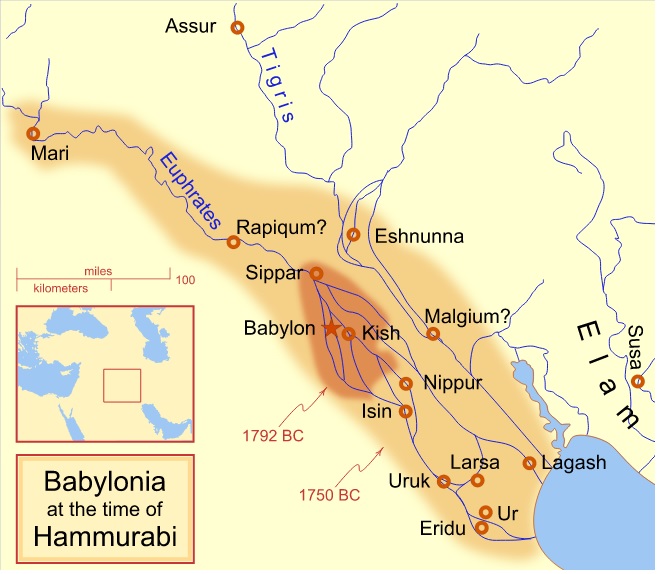
Hammurabi
(c. 1810-- c. 1750 BC) the sixth Amorite king of the Old Babylonian Empire, best known for having issued the Code of Hammurabi, which he claimed to have received from Shamash, the Babylonian god of justice. It prescribed specific penalties for each crime and is among the first codes to establish the presumption of innocence. Source of "An eye for an eye and a tooth for a tooth."
Early Dynastic Period (Egypt)
the era immediately following the unification of Upper and Lower Egypt c. 3100 BC. It is generally taken to include the First and Second Dynasties, lasting
from the end of the Naqada III archaeological period until about 2686 BC, or the beginning of the Old Kingdom. With the First Dynasty, the capital moved from
Thinis to Memphis with a unified Egypt ruled by an Egyptian god-king. Abydos
Memphis, Egypt
(Founded Earlier than 31st century BC, abandoned 7th century AD) ancient capital of Inebu-hedj, the first nome of Lower Egypt. Its ruins are located near the town of Mit Rahina, 20 km (12 mi) south of Giza in Greater
Cairo, Egypt. It was the Capital of ancient Egypt during the Old Kingdom and remained an important city throughout ancient Egyptian history.
Its eventual downfall is believed to have been due to the loss of its economic significance in late antiquity, following the rise of coastal Alexandria. Its religious significance was diminished after the abandonment of the ancient religion following the Edict of Thessalonica in 380 AD that enforced adoption of Nicene Christianity solely throughout the Roman Empire.
Ramesses II
(1279-1213 BC) the third pharaoh of the Nineteenth Dynasty of Egypt. He is often regarded as the greatest, most celebrated, and most powerful pharaoh of the New Kingdom,
itself the most powerful period of Ancient Egypt.[8] His successors and later Egyptians called him the "Great Ancestor".
He is known as Ozymandias in Greek sources
Hittites
(c. 1680 BC-1178 BC) [Today part of Turkey, Syria, Lebanon and Cyprus] an Anatolian people who played an important role in establishing an empire centered on Hattusa in north-central Anatolia around 1680-1650 BCE. This empire
reached its height during the mid-14th century BC under Suppiluliuma I, when it encompassed an area that included most of Anatolia as well as parts of the
northern Levant and Upper Mesopotamia.
he development of iron smelting was once attributed to the Hittites of Anatolia during the Late Bronze Age. But the view of such a "Hittite monopoly" has
come under scrutiny and is no longer a scholarly consensus.
The Hittites, also spelled Hethites, were a group of people mentioned in the Hebrew Bible. hey are described several times as living in or near Canaan
between the time of Abraham (estimated to be between 2000 BC and 1500 BC) and the time of Ezra after the return of the Jews from the Babylonian exile (around
450 BC).
Carthage
(Founded by Phoenician settlers c. 814 BC, Destroyed by Roman Republic 146 BC) [Today Tunisia]
(Also known as Punics) After gaining independence in the seventh century BC, Carthage gradually expanded its economic and political hegemony across northwest Africa, Iberia, and
the major islands of the western Mediterranean. By 300 BC, it became one of the largest and richest cities in antiquity, with its colonies, vassals, and
satellite states constituting more territory than any other polity in the region. Carthage's wealth and power rested primarily on its strategic location,
which provided access to abundant fertile land and major trade routes. Its vast mercantile network, which extended as far as west Africa and northern Europe,
provided an array of commodities from all over the ancient world, as well as lucrative exports of agricultural goods and manufactured products. This
commercial empire was secured by one of the largest and most powerful navies in the ancient Mediterranean, and an army composed largely of foreign
mercenaries and auxiliaries.
Conquests of the Persian Empire by Alexander the Great
336-323 BC King Alexander III of Macedon ("The Great"), first against the Achaemenid Persian Empire under Darius III, and then against local chieftains and
warlords as far east as Punjab, India. His conquests included Anatolia, Syria, Phoenicia, Judea, Gaza, Egypt, Mesopotamia, Persia and Bactria, and he
extended the boundaries of his own empire as far as Taxila, India.
Ptolemaic Kingdom
a Hellenistic kingdom based in ancient Egypt. It was ruled by the Ptolemaic dynasty, which started with Ptolemy I Soter's accession after the death of
Alexander the Great in 323 BC and which ended with the death of Cleopatra and the Roman conquest in 30 BC. Alexandria, a Greek polis founded by Alexander the
Great, became the capital city and a major center of Greek culture and trade.
Ptolemy I Soter
(c. 367 BC - January 282 BC) a companion and historian of Alexander the Great of the Kingdom of Macedon in northern Greece who became ruler of Egypt, part of Alexander's former empire. Ptolemy was pharaoh of Ptolemaic Egypt from 305/304 BC[1] to his death. He was the founder of the Ptolemaic dynasty which ruled Egypt until the death of Cleopatra in 30 BC, turning the country into a Hellenistic kingdom and Alexandria into a center of Greek culture.
Cyrus the Great
(c. 600-530 BC) Founder of the Achaemenid Empire, the first Persian Empire. Under his rule, the empire embraced all the previous civilized states of the ancient Near East, expanded vastly and eventually conquered most of Western Asia and much of Central Asia. From the Mediterranean Sea and Hellespont in the west to the Indus River in the east, Cyrus the Great created the largest empire the world had yet seen.
Cyrus the Great respected the customs and religions of the lands he conquered. This became a very successful model for centralized administration and establishing a government working to the advantage and profit of its subjects. What is sometimes referred to as the Edict of Restoration (actually two edicts) described in the Bible as being made by Cyrus the Great left a lasting legacy on the Jewish religion. According to Isaiah 45:1 of the Hebrew Bible, God anointed Cyrus for this task, even referring to him as a messiah (lit. 'anointed one') and he is the only non-Jewish figure in the Bible to be called so.
Darius III
(c. 380 - July 330 BC), originally named Artashata and called Codomannus by the Greeks, was the last king of the Achaemenid Empire of Persia, from 336 BC to
330 BC.
In 334 BC, Alexander the Great began his invasion of the Persian Empire and subsequently defeated the Persians in a number of battles before looting and destroying their capital, Persepolis, by fire in 330 BC. With the Persian Empire now effectively under Alexander's control, Alexander then decided to pursue Darius. Before Alexander reached him, however, Darius was killed by his cousin Satrap Bessus.
Saladin
(1137-1193) The first sultan of Egypt and Syria and the founder of the Ayyubid dynasty. A Sunni Muslim of Kurdish ethnicity, Saladin led the Muslim military campaign against the Crusader states in the Levant.
Under Saladin's command, the Ayyubid army defeated the Crusaders at the decisive Battle of Hattin in 1187, and thereafter wrested control of Palestine--including the city of Jerusalem--from the Crusaders, who had conquered the area 88 years earlier. Although the Crusader Kingdom of Jerusalem continued to exist until the late 13th century, its defeat at Hattin marked a turning point in its conflict with the Muslim powers of the region.
Claudius Ptolemy
(100-170 AD) mathematician, astronomer, natural philosopher, geographer and astrologer. Wrote astronomical treatise now known as the Almagest. Ptolemy wrote in ancient Greek and can be shown to have utilized Babylonian astronomical data. He might have been a Roman citizen, but was ethnically either a Greek or a Hellenized Egyptian.
Ptolemy's Almagest is the only surviving comprehensive ancient treatise on astronomy, and was the authoritative text on astronomy across Europe, the Middle East and North Africa in the Medieval period. Ptolemy's model, like those of his predecessors, was geocentric and was almost universally accepted until the appearance of simpler heliocentric models during the scientific revolution.
Aramaic
language, part of the Northwest Semitic group, which also includes the Canaanite languages such as Hebrew and Phoenician. The Aramaic alphabet was widely
adopted for other languages and is ancestral to the Hebrew, Syriac and Arabic alphabets. During its approximately 3,100 years of written history, Aramaic has
served variously as a language of administration of empires, as a language of divine worship and religious study
Aramaic rose to prominence under the Neo-Assyrian Empire (911-605 BC), under whose influence Aramaic became a prestige language, and its use spread
throughout most of Mesopotamia and the Levant. At its height, variants of Aramaic were spoken all over in what is today Iraq, Syria, Lebanon, Palestine,
Israel, Jordan, Kuwait, Eastern Arabia, Northern Arabia, and to a lesser extent parts of southeast and south central Turkey, and parts of northwest Iran.
Aramaic was the language of Jesus, who spoke the Galilean dialect during his public ministry, as well as the language of large sections of the biblical books
of Daniel and Ezra, and also one of the languages of the Talmud.
Gaul
(5th Century-1st Century BC, 51BC-AD 486 [ROMAN] AD 486- [FRANKISH]) [Today France, Luxembourg, Belgium, most of Switzerland, and parts of Northern Italy, the Netherlands, and Germany]
a region of Western Europe first described by the Romans. It was inhabited by Celtic tribes. the Gauls were bearers of the La Tene culture, which extended
across all of Gaul, as well as east to Raetia, Noricum, Pannonia, and southwestern Germania during the 5th to 1st centuries BC. During the 2nd and 1st
centuries BC, Gaul fell under Roman rule: Gallia Cisalpina was conquered in 203 BC and Gallia Narbonensis in 123 BC. Gaul was invaded after 120 BC by the
Cimbri and the Teutons, who were in turn defeated by the Romans by 103 BC. Julius Caesar finally subdued the remaining parts of Gaul in his campaigns of 58
to 51 BC.

History of Mathematics
The history of mathematics can be seen as an ever-increasing series of abstractions.
numbers:
(the realization that a collection of two apples and a collection of two oranges (for example) have something in common, namely quantity of their members.)
abstract quantities
like time—days, seasons, or years.
Babylonian mathematics
(1830-1531 BC) fractions, algebra, quadratic and cubic equations and the Pythagorean theorem.


Archimedes
(c. 287-c. 212 BC) anticipated modern calculus and analysis by applying concepts of infinitesimals and the method of exhaustion to derive and rigorously
prove a range of geometrical theorems, including
the area of a circle,
the surface area and volume of a sphere,
the area under a parabola.
deriving an accurate approximation of pi,
defining and investigating the spiral bearing his name,
creating a system using exponentiation for expressing very large numbers.
He was also one of the first to apply mathematics to physical phenomena, founding hydrostatics and statics, including an explanation of the
principle of the lever.
He is credited with designing innovative machines, such as his
screw pump
compound pulleys
and defensive war machines to protect his native Syracuse from invasion.
Bede
(673-735)
English Benedictine monk at the monastery of St. Peter and its companion monastery of St. Paul in the Kingdom of Northumbria of the Angles (contemporarily Monkwearmouth–Jarrow Abbey in Tyne and Wear, England).
His most famous work, Ecclesiastical History of the English People, gained him the title "The Father of English History". Another important area of study for Bede was the academic discipline of computus, otherwise known to his contemporaries as the science of calculating calendar dates. One of the more important dates Bede tried to compute was Easter, an effort that was mired in controversy.
East–West Schism
The East–West Schism (also the Great Schism or Schism of 1054) is the break of communion since the 11th century between the Catholic Church and Eastern Orthodox Churches. A succession of ecclesiastical differences and theological disputes between the Greek East and Latin West pre-dated the formal split that occurred in 1054.
In 1053, the first step in the process which led to a formal schism was taken: the Greek churches in southern Italy were forced to conform to Latin practices and if any of them did not, they were forced to close. In retaliation, the Ecumenical Patriarch of Constantinople Michael I Cerularius ordered the closure of all Latin churches in Constantinople. The schism was the culmination of theological and political differences which had developed during the preceding centuries between Eastern and Western Christianity.
Byzantine Empire
also referred to as the Eastern Roman Empire, or Byzantium, was the continuation of the Roman Empire in its eastern provinces during Late Antiquity and the Middle Ages, when its capital city was Constantinople (modern Istanbul, formerly Byzantium). It survived the fragmentation and fall of the Western Roman Empire in the 5th century AD and continued to exist for an additional thousand years until it fell to the Ottoman Empire in 1453.[1] During most of its existence, the empire was the most powerful economic, cultural, and military force in Europe.
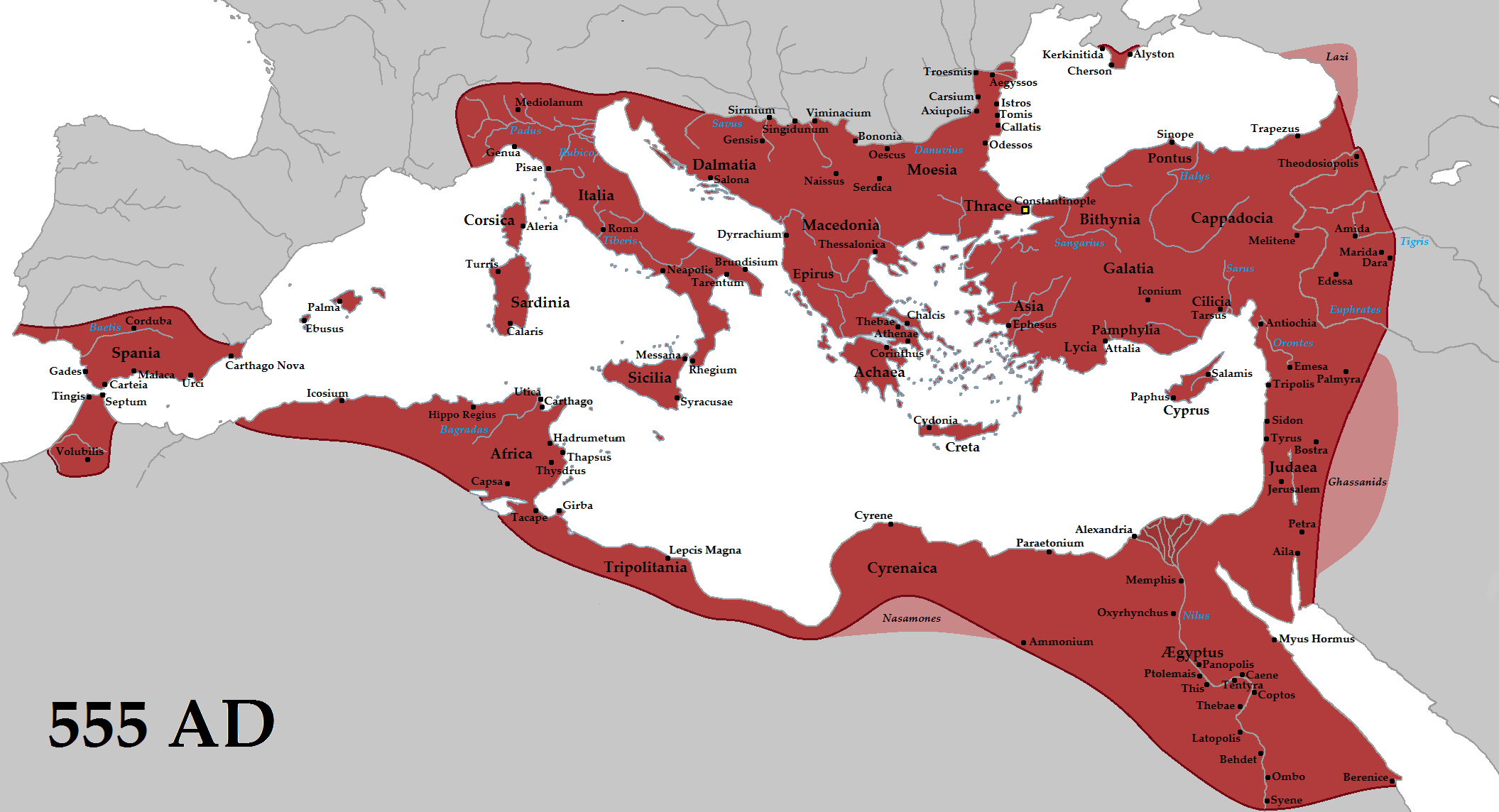
Ottoman Empire
A state that controlled much of Southeastern Europe, Western Asia, and Northern Africa between the 14th and early 20th centuries. It was founded at the end of the 13th century in northwestern Anatolia.
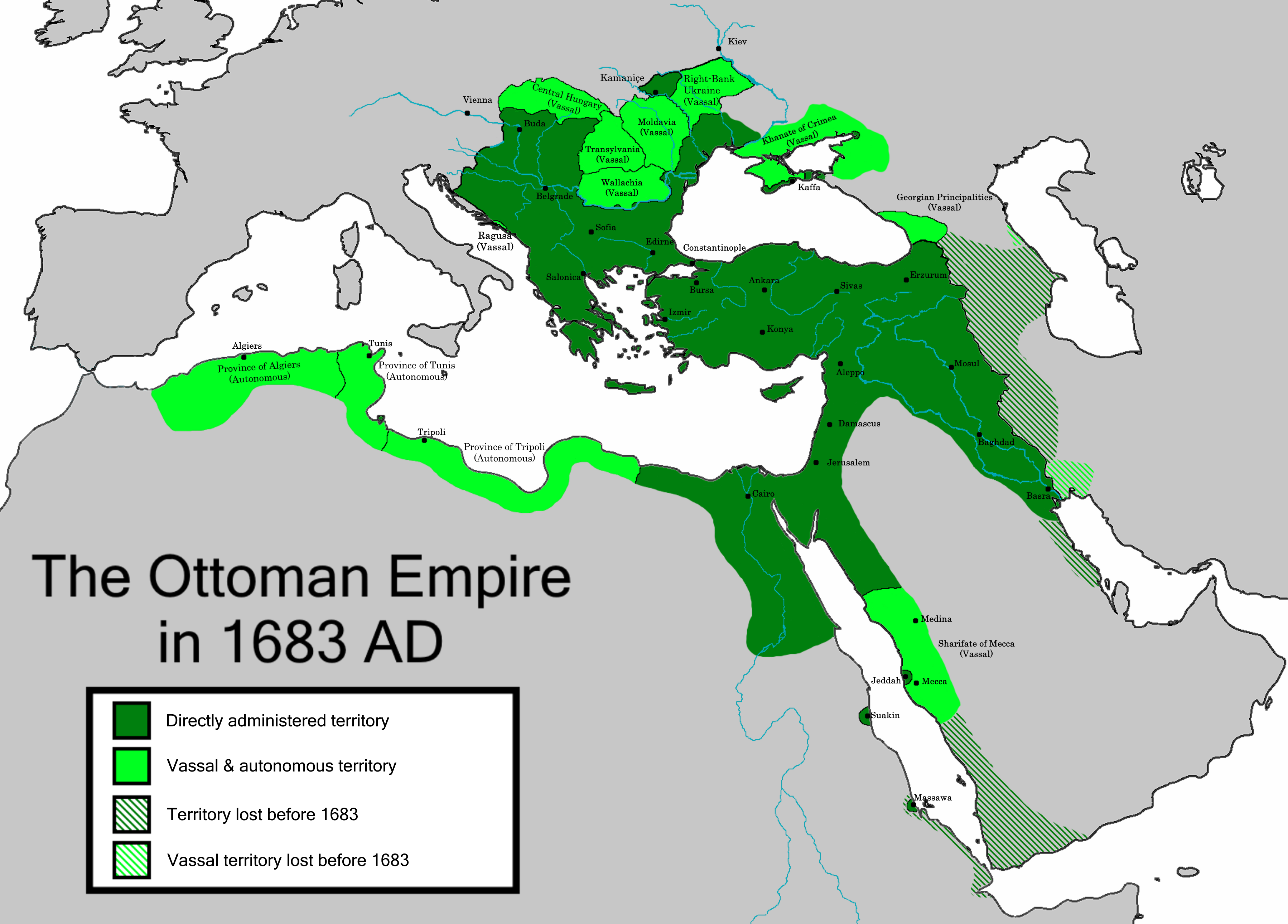
Mongol Empire
The Mongol Empire of the 13th and 14th centuries was the largest contiguous
land empire in history. Originating in Mongolia in East Asia, the Mongol
Empire eventually stretched from Eastern Europe and parts of Central Europe
to the Sea of Japan, extending northward into parts of the Arctic; eastward
and southward into the Indian subcontinent, Mainland Southeast Asia and
the Iranian Plateau; and westward as far as the Levant and the Carpathian
Mountains.
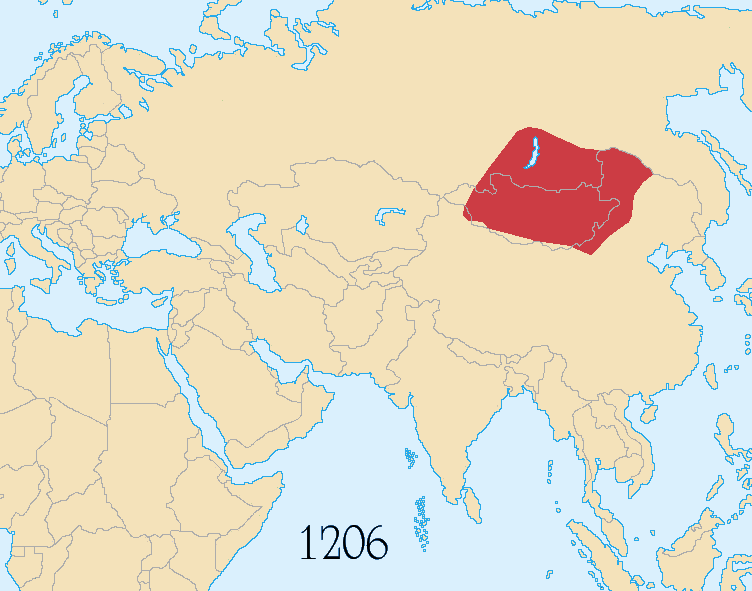
Umayyad Caliphate
The second of the four major caliphates established after the death of Muhammad. The family established dynastic, hereditary rule with Muawiya ibn Abi Sufyan, long-time governor of al-Sham (Greater Syria), who became the sixth caliph after the end of the First Muslim Civil War in 661. The region of Syria remained the Umayyads' main power base thereafter, and Damascus was their capital.
At its greatest extent, the Umayyad Caliphate covered 11,100,000 km2 (4,300,000 sq mi),[1] making it one of the largest empires in history in terms of area. The dynasty was eventually overthrown by a rebellion led by the Abbasids in 750. Survivors of the dynasty established themselves in Cordoba which, in the form of an emirate and then a caliphate, became a world centre[6][7] of science, medicine, philosophy and invention, ushering in the period of the Golden Age of Islam.
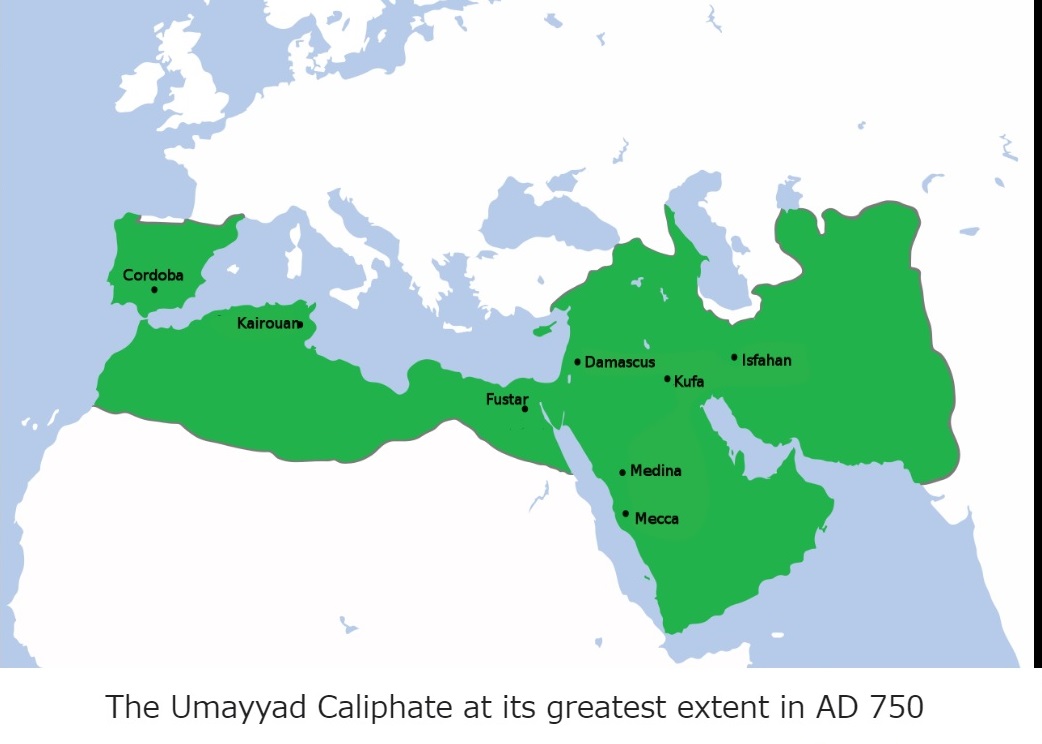
Peace of Westphalia
a series of peace treaties which were signed between May and October 1648 in the Westphalian cities of Osnabruck and Munster, largely ending the European
wars of religion, including the Thirty Years' War. The treaties of Westphalia brought to an end a calamitous period of European history which caused the
deaths of approximately eight million people. Scholars have identified Westphalia as the beginning of the modern international system. A new system of
political order arose in central Europe, based upon peaceful coexistence among sovereign states. Inter-state aggression was to be held in check by a balance
of power, and a norm was established against interference in another state's domestic affairs.
European wars of religion
waged in Europe in the 16th, 17th and early 18th centuries. The wars, which were fought after the Protestant Reformation began in 1517, disrupted the
religious and political order in the Catholic countries of Europe. However, religion was not the only cause of the wars, which also included revolts,
territorial ambitions, and Great Power conflicts. For example, by the end of the Thirty Years' War (1618-1648), Catholic France was allied with the
Protestant forces against the Catholic Habsburg monarchy.
Council of Trent
held between 1545 and 1563 in Trent (or Trento, in northern Italy), was the 19th ecumenical council of the Catholic Church. Prompted by the Protestant
Reformation, it has been described as the embodiment of the Counter-Reformation. The Council issued condemnations of what it defined to be heresies committed
by proponents of Protestantism, The Counter-Reformation was initiated to preserve the power, influence and material wealth enjoyed by the Catholic Church and
to present a theological and material challenge to Reformation
Protestant Union
a coalition of Protestant German states. It was formed on May 14, 1608
by Frederick IV, Elector Palatine in order to defend the rights, land and
safety of each member.
It included both Calvinist and Lutheran states, and dissolved in 1621.
The Protestant Union was weakened from the start by the non-participation
of several powerful German Protestant rulers, notably the Elector of Saxony.
The Union
was also beset by internal strife between its Lutheran and Calvinist members.
Calvinist
(=Afrikaners =South African
Huguenots = French Protestant
Pilgrims
Puritans)
The Great Trek (Afrikaans: Die Groot Trek; Dutch: De Grote Trek) was an eastward migration of Dutch-speaking settlers (called Voortrekkers) who travelled by
wagon from the Cape Colony into the interior of modern South Africa from 1836 onwards, seeking to live beyond the Cape's British colonial administration.
Lutheran
Unlike Calvinism, Lutherans retain many of the liturgical practices and sacramental teachings of the pre-Reformation Church, with a particular emphasis on
the Eucharist, or Lord's Supper.
Norte Chico civilization
(3700 to 1800 BC) a complex pre-Columbian-era society that included as many as thirty major
population centers in what is now the Norte Chico region of north-central
coastal
Peru. The civilization flourished between the fourth and second millennia BC, with the formation of the first city generally dated to around 3500 BC, at
Huaricanga, in the Fortaleza area. It is from 3100 BC onward that large-scale human settlement and communal construction become clearly apparent
Maya civilization
a Mesoamerican civilization developed by the Maya peoples, and noted for its logosyllabic script--the most sophisticated and highly developed writing system
in pre-Columbian Americas--as well as for its art, architecture, mathematics, calendar, and astronomical system. The Maya civilization developed in an area
that encompasses southeastern Mexico, all of Guatemala and Belize, and the western portions of Honduras and El Salvador.
The first Maya cities developed around 750 BC, and by 500 BC these cities possessed monumental architecture, including large temples with elaborate stucco
facades. Hieroglyphic writing was being used in the Maya region by the 3rd century BC.
Beginning around 250 AD, the Classic period is largely defined as when the Maya were raising sculpted monuments with Long Count dates. This period saw the
Maya civilization develop many city-states linked by a complex trade network. In the Maya Lowlands two great rivals, the cities of Tikal and Calakmul, became
powerful. The Classic period also saw the intrusive intervention of the central Mexican city of Teotihuacan in Maya dynastic politics.
El Castillo, Chichen Itza
a Mesoamerican step-pyramid that dominates the center of the Chichen Itza archaeological site in the Mexican state of Yucatan. Built by the pre-Columbian
Maya civilization sometime between the 8th and 12th centuries CE or AD, El Castillo served as a temple to the god Kukulkan, the Yucatec Maya Feathered
Serpent deity closely related to the god Quetzalcoatl known to the Aztecs

Quetzalcoatl
a deity in Mesoamerican culture and literature whose name comes from the Nahuatl language and means "feathered serpent" or "Quetzal-feathered Serpent".
The earliest known documentation of the worship of a Feathered Serpent occurs in Teotihuacan in the first century BC or first century AD.
Quetzalcoatl, the Aztec god of wind, air, and learning, wears around his neck the "wind breastplate" ehecailacocozcatl, "the spirally voluted wind jewel"
made of a conch shell. This talisman potentially symbolized patterns witnessed in hurricanes, dust devils, seashells, and whirlpools, which were elemental
forces that had significance in Aztec mythology.
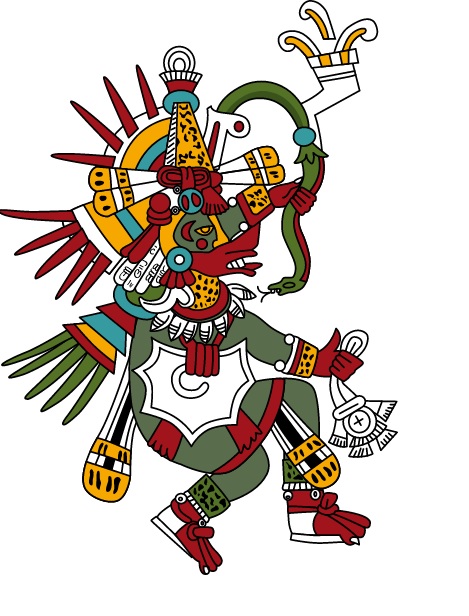
Yaxchilan
ancient Maya city located on the bank of the Usumacinta River in the state of Chiapas, Mexico. The site is particularly known for its well-preserved sculptured stone lintels set above the doorways of the main structures.[3] These lintels, together with the stelae erected before the major buildings, contain hieroglyphic texts describing the dynastic history of the city.
The known history of Yaxchilan starts with the enthronement of Yopaat B'alam I, most likely on 23 July 359.[13] He was the founder of a long dynasty, and took the throne when Yaxchilan was still a minor site.[12] Hieroglyphic inscriptions dating to the Late Classic describe a series of wars in the Early Classic between the city and its neighbours.

Teotihuacan
ancient Mesoamerican city located in a sub-valley of the Valley of Mexico, which is located in the State of Mexico, 40 kilometres (25 mi) northeast of
modern-day Mexico City. Teotihuacan is known today as the site of many of the most architecturally significant Mesoamerican pyramids built in the pre-
Columbian Americas. Also anthropologically significant for its complex, multi-family residential compounds, the Avenue of the Dead, and its vibrant murals
that have been well-preserved. Additionally, Teotihuacan exported fine obsidian tools that are found throughout Mesoamerica. The city is thought to have been
established around 100 BCE, with major monuments continuously under construction until about 250 CE. The city may have lasted until sometime between the 7th
and 8th centuries CE, but its major monuments were sacked and systematically burned around 550 CE.
Toltec
archaeological Mesoamerican culture that dominated a state centered in Tula, Hidalgo, Mexico in the early post-classic period of Mesoamerican chronology
(ca. 900-1168 CE). The later Aztec culture saw the Toltecs as their intellectual and cultural predecessors
Atahualpa
(c. 1502-26 July 1533) the last Inca Emperor. After defeating his brother,
Atahualpa became very briefly the last Sapa Inca (sovereign emperor) of
the Inca Empire
(Tawantinsuyu) before the Spanish conquest ended his reign.
The Spaniard Francisco Pizarro captured Atahualpa in November 1532 and
used him to control the Inca Empire. While imprisoned by the Spaniards,
Atahualpa gave
orders to kill Huáscar in Jauja, thinking Huáscar would use the Spaniards
as allies to regain his throne.[7]
The Spanish eventually executed Atahualpa, effectively ending the empire.
A succession of emperors, who led the Inca resistance against the invading
Spaniards,
claimed the title of Sapa Inca as rulers of the Neo-Inca State, but the
empire began to disintegrate after Atahualpa's death.
Toussaint Louverture
20 May 1743 - 7 April 1803 a Haitian general and best-known leader of the Haitian Revolution. He was a leader of the growing resistance. His military and
political acumen saved the gains of the first black insurrection in November 1791. He first fought for the Spanish against the French; then for France
against Spain and Great Britain; and finally, he fought on behalf of Saint-Domingue in the era of Napoleonic France. He helped transform the slave insurgency
into a revolutionary movement.
Salic law
civil law code compiled around AD 500 by the first Frankish King, Clovis. Recorded in Latin and in what Dutch linguists describe as one of the earliest known
records of Old Dutch, perhaps second only to the Bergakker inscription,[1] it remained the basis of Frankish law throughout the early Medieval period, and
influenced future European legal systems
Bergakker inscription
an Elder Futhark inscription discovered on the scabbard of a 5th-century sword. It was found in 1996 in the Dutch town of Bergakker, near Tiel (in the
Betuwe, once the habitat of the Batavi).[1] There is consensus that the find dates from the period 425-475 and that the inscription is either the singular
direct attestation of Frankish (Franconian) or the earliest attestation of Old Dutch (Old Low Franconian).
Runes
the letters in a set of related alphabets known as runic alphabets, which were used to write various Germanic languages before the adoption of the Latin
alphabet and for specialised purposes thereafter. The Scandinavian variants are also known as futhark or futark (derived from their first six letters of the
alphabet: F, U, T, A, R, and K); the Anglo-Saxon variant is futhorc or futorc (due to sound changes undergone in Old English by the names of those six
letters). The characters were generally replaced by the Latin alphabet as the cultures that had used runes underwent Christianisation, by approximately 700
AD in central Europe and 1100 AD in northern Europe.
Edward III of England
(13 November 1312 - 21 June 1377)
noted for his military success and for restoring royal authority after the disastrous and unorthodox reign of his father, Edward II. Edward III transformed
the Kingdom of England into one of the most formidable military powers in Europe. His long reign of 50 years was the second longest in medieval England and
saw vital developments in legislation and government-in particular the evolution of the English parliament-as well as the ravages of the Black Death.
Siege of Orleans
(1428-1429) was the watershed of the Hundred Years' War between France
and England. It was the French Royal army's first major military victory
while Joan of
Arc was with the army and the first to follow the crushing defeat at Agincourt in 1415.
Battle of Tours
(10 October 732)
fought by Frankish and Burgundian[22][23] forces under Charles Martel against an army of the Umayyad Caliphate led by 'Abdul Rahman Al Ghafiqi, Governor-
General of al-Andalus.
Al-Andalus
also known as Muslim Spain or Islamic Iberia, was a medieval Muslim territory and cultural domain occupying at its peak most of what are today Spain and
Portugal. At its greatest geographical extent in the 8th century, southern France-Septimania-was briefly under its control.
Charlemagne
(2 April 742[1][b] - 28 January 814)
King of the Franks from 768, King of the Lombards from 774 and Emperor of the Romans from 800. He united much of Europe during the early Middle Ages. He was
the first recognised[by whom-] emperor in western Europe since the fall of the Western Roman Empire three centuries earlier.
He campaigned against the Saxons to his east, Christianising them upon penalty of death and leading to events such as the Massacre of Verden. Charlemagne
reached the height of his power in 800 when he was crowned Emperor of the Romans by Pope Leo III on Christmas Day at Rome's Old St. Peter's Basilica.
Charlemagne has been called the "Father of Europe" (Pater Europae),[c] as he united most of Western Europe for the first time since the Roman Empire and
united parts of Europe that had never been under Roman rule. His rule spurred the Carolingian Renaissance, a period of energetic cultural and intellectual
activity within the Western Church. All Holy Roman Emperors considered their kingdoms to be descendants of Charlemagne's empire,
Dagobert I
(c. 603 – 19 January 639 AD) was the king of Austrasia (623–634), king
of all the Franks (629–634), and king of Neustria and Burgundy (629–639).
He was the last king of the Merovingian dynasty to wield any real royal
power.
Merovingian
a Salian Frankish dynasty that ruled the Franks for three centuries in
a region known as Francia in Latin, beginning in the middle of the 5th
century. Their territory largely corresponded to ancient Gaul as well as
the Roman provinces of Raetia, Germania Superior and the southern part
of Germania.
Simon Magus
Cecco d'Ascoli
